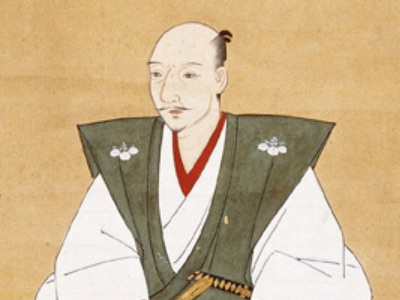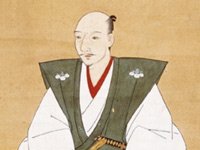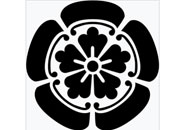Oda Nobunaga (1534-1582)

Rise to Power
Battle of Okehazama
In 1560, Imagawa Yoshimoto gathered an army of 40,000 men and started his march toward Kyoto, with the pretext of aiding the frail Ashikaga shogunate. The Matsudaira clan of Mikawa Province also joined Yoshimoto's forces. Against this, the Oda clan could rally an army of only 2,000 to 3,000. Some of Nobunaga's advisers suggested "to stand a siege at Kiyosu". Nobunaga refused, stating that "only a strong offensive policy could make up for the superior numbers of the enemy," and calmly ordered a counterattack.
Nobunaga's scouts reported that Yoshimoto was resting at the narrow gorge of Dengaku-hazama, ideal for a surprise attack, and that the Imagawa army were celebrating their victories while Yoshimoto viewed the heads. Nobunaga moved towards Imagawa's camp, and set up a position some distance away. An array of flags and dummy troops made of straw and spare helmets gave the impression of a large host, while the real Oda army hurried round in a rapid march to get behind Yoshimoto's camp. The heat gave way to a terrific thunderstorm. As the Imagawa samurai sheltered from the rain Nobunaga deployed his troops, and when the storm ceased they charged down upon the enemy in the gorge, so suddenly that Yoshimoto thought a brawl had broken out among his men, only realizing it was an attack when two samurai charged up. One aimed a spear at him, which Yoshimoto deflected with his sword, but the second swung his blade and cut off Imagawa's head.
Rapidly weakening in the wake of this battle, the Imagawa clan no longer exerted control over the Matsudaira clan. In 1561, an alliance was forged between Oda Nobunaga and Matsudaira Motoyasu (who would become Tokugawa Ieyasu), despite the decades-old hostility between the two clans. Nobunaga also formed an alliance with Takeda Shingen through the marriage of his daughter to Shingen's son. A similar relationship was forged when Nobunaga's sister Oichi married Azai Nagamasa of Ōmi Province.
Tradition dates this battle as the first time that Nobunaga noticed the talents of the sandal-bearer who would eventually become Toyotomi Hideyoshi.
Siege of Inabayama Castle
In Mino, Saitō Yoshitatsu died suddenly of illness in 1561, and was succeeded by his son, Saitō Tatsuoki. Tatsuoki, however, was young and much less effective as a ruler and military strategist compared to his father and grandfather.
Taking advantage of this situation, Nobunaga moved his base to Komaki Castle and started his campaign in Mino at the 1561 Battle of Moribe. By convincing Saitō retainers to abandon their incompetent and foolish master, Nobunaga weakened the Saitō clan significantly, eventually mounting a final attack in 1567. Nobunaga captured Inabayama Castle and sent Tatsuoki into exile.
After taking possession of the castle, Nobunaga changed the name of both the castle and the surrounding town to Gifu. Remains of Nobunaga's residence in Gifu can be found today in Gifu Park. Nobunaga revealed his ambition to conquer the whole of Japan. He also started using a new personal seal that read Tenka Fubu (天下布武), which means "All the world by force of arms" or "Rule the Empire by Force".
Campaign in Kyoto
In 1568, Ashikaga Yoshiaki went to Gifu to ask Nobunaga to start a campaign toward Kyoto. Yoshiaki was the brother of the murdered thirteenth shogun of the Ashikaga shogunate, Yoshiteru, and wanted revenge against the killers who had already set up a puppet shogun, Ashikaga Yoshihide. Nobunaga agreed to install Yoshiaki as the new shogun and, grasping the opportunity to enter Kyoto, started his campaign. An obstacle in southern Ōmi Province, however, was the Rokkaku clan. Led by Rokkaku Yoshikata, the clan refused to recognize Yoshiaki as shogun and was ready to go to war. In response, Nobunaga launched a rapid attack, driving the Rokkaku clan out of their castles.
Within a short amount of time, Nobunaga had reached Kyoto and driven the Miyoshi clan out of the city. Yoshiaki was made the 15th shogun of the Ashikaga shogunate. Nobunaga refused the post of Kanrei (the Shogunal deputy), and eventually began to restrict the powers of the shogun, making it clear that he intended to use him as a façade to justify his future conquests. Yoshiaki, however, was not pleased about being a puppet and secretly corresponded with various daimyo, forging an anti-Nobunaga alliance.
HISTORY

RESOURCES
This article uses material from the Wikipedia article "Oda Nobunaga (1534-1582)", which is released under the Creative Commons Attribution-Share-Alike License 3.0.
© Stories Preschool. All Rights Reserved.









